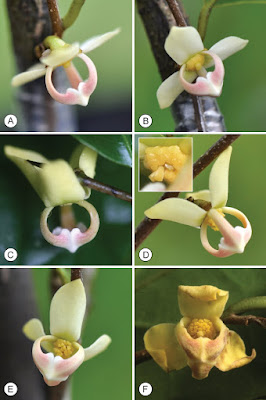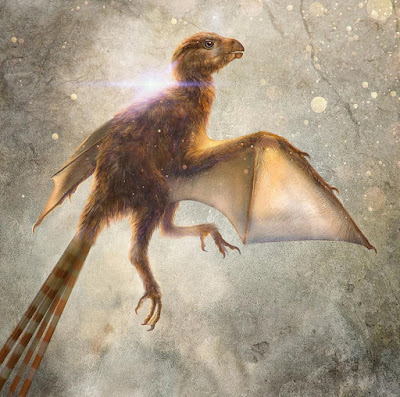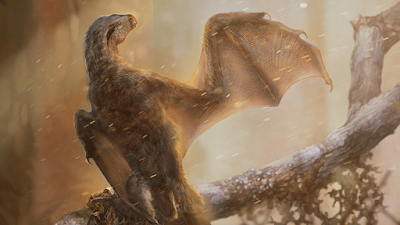[Most Recent Entries] [Calendar View]
Thursday, May 9th, 2019
| Time | Event | ||
| 3:21a | [Ichthyology • 2019] Aenigmachanna gollum • A New Genus and Species of Subterranean Snakehead (Teleostei: Channidae) from Kerala, South India
Abstract Aenigmachanna gollum, new genus and species, is described from Kerala, South India. It is the first subterranean species of the family Channidae. It has numerous derived and unique characters, separating it from both the Asian Channa Scopoli and the African Parachanna Teugels & Daget. Uniquely among channids, A. gollum has a very slender (maximum body depth only 11.1–11.3% SL), eel-like body (head length 20.8–21.6% SL), large mouth (jaw length 60.4–61.1 % HL), 43–44 anal-fin rays, 83–85 scales in a lateral series, an unusual colour pattern and it lacks pored lateral-line scales on the body and body buoyancy. In addition, it is distinguished by its DNA barcode sequence, which is 15.8–24.2% divergent from other species of the family Channidae. Morphological modifications usually associated with a subterranean life, such as reduction of eyes and enhancement of non-visual senses (taste, smell, mechanosensory systems) are absent in A. gollum. However, it shares with subterranean fishes a slight reduction of its pigmentation in comparison to epigean channids. Keywords: Western Ghats-Sri Lanka biodiversity hotspot, relict lineages, laterite, aquifer, Pisces Ralf Britz, V.K. Anoop, Neelesh Dahanukar and Rajeev Raghavan. 2019. The Subterranean Aenigmachanna gollum, A New Genus and Species of Snakehead (Teleostei: Channidae) from Kerala, South India. Zootaxa. 4603(2); 377–388. DOI: 10.11646/zootaxa.4603.2.10 | ||
| 4:08a | [Botany • 2019] Mitrephora monocarpa (Annonaceae) พรหมพนม • A New Species from Surat Thani Province, Peninsular Thailand
Abstract A new species, Mitrephora monocarpa R.M.K.Saunders & Chalermglin, sp. nov. (Annonaceae), is described from Surat Thani Province in Peninsular Thailand. It resembles two other species, M. alba Ridl. and M. keithii Ridl., with which it is broadly sympatric, but can be distinguished by its solitary flowers (not borne in thyrsoid inflorescences as in most other Mitrephora species), single carpel per flower (and hence single monocarp per fruit) and the lack of a monocarp stipe. A key to the nine Mitrephora species in Thailand is provided. Keywords: Annonaceae, Mitrephora monocarpa, Thailand, new species Mitrephora monocarpa R.M.K.Saunders & Chalermglin, sp. nov. Diagnosis: A new species similar to M. alba and M. keithii, but distinguished by its solitary flowers that are not borne in an inflorescence, its single carpel per flower and single sessile monocarp per fruit. .... Distribution and habitat: Mitrephora monocarpa is only known from the type collection cited above, from a tropical rain forest over limestone, ca. 250 m elevation. Etymology: The specific epithet reflects the fact that the flower has only a single carpel and, hence, the fruit consists of a solitary monocarp. Local name: Phrom Phanom (พรหมพนม). Richard M.K. Saunders and Piya Chalermglin. 2019. Mitrephora monocarpa (Annonaceae): A New Species from Surat Thani Province, Peninsular Thailand. PhytoKeys. 121: 73-80. DOI: 10.3897/phytokeys.121.34271 | ||
| 4:09a | [Paleontology • 2019] Ambopteryx longibrachium • A New Jurassic Scansoriopterygid and the Loss of Membranous Wings in Theropod Dinosaurs
Abstract Powered flight evolved independently in vertebrates in the pterosaurs, birds and bats, each of which has a different configuration of the bony elements and epidermal structures that form the wings. Whereas the early fossil records of pterosaurs and bats are sparse, mounting evidence (primarily from China) of feathered non-avian dinosaurs and stemward avians that derive primarily from the Middle–Upper Jurassic and Lower Cretaceous periods has enabled the slow piecing together of the origins of avian flight. These fossils demonstrate that, close to the origin of flight, dinosaurs closely related to birds were experimenting with a diversity of wing structures. One of the most surprising of these is that of the scansoriopterygid (Theropoda, Maniraptora) Yi qi, which has membranous wings—a flight apparatus that was previously unknown among theropods but that is used by both the pterosaur and bat lineages. This observation was not universally accepted. Here we describe a newly identified scansoriopterygid—which we name Ambopteryx longibrachium, gen. et sp. nov.—from the Upper Jurassic period. This specimen provides support for the widespread existence of membranous wings and the styliform element in the Scansoriopterygidae, as well as evidence for the diet of this enigmatic theropod clade. Our analyses show that marked changes in wing architecture evolved near the split between the Scansoriopterygidae and the avian lineage, as the two clades travelled along very different paths to becoming volant. The membranous wings supported by elongate forelimbs that are present in scansoriopterygids probably represent a short-lived experimentation with volant behaviour, and feathered wings were ultimately favoured during the later evolution of Paraves. Min Wang, Jingmai K. O’Connor, Xing Xu and Zhonghe Zhou. 2019. A New Jurassic Scansoriopterygid and the Loss of Membranous Wings in Theropod Dinosaurs. Nature. 569; 256–259. DOI: 10.1038/s41586-019-1137-z Newly Discovered Bat-Like Dinosaur Reveals the Intricacies of Prehistoric Flight po.st/FwnL8Q via @SmithsonianMag New species of bat-wing dinosaur discovered on.natgeo.com/2VQ07Dq via @NatGeoScience |
| << Previous Day |
2019/05/09 [Calendar] |
Next Day >> |














